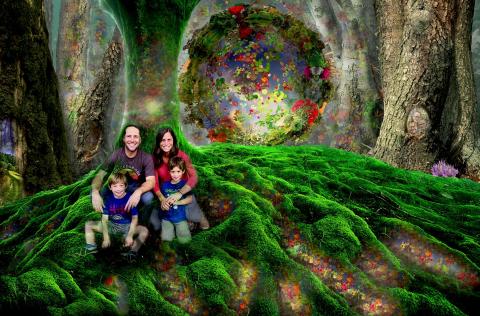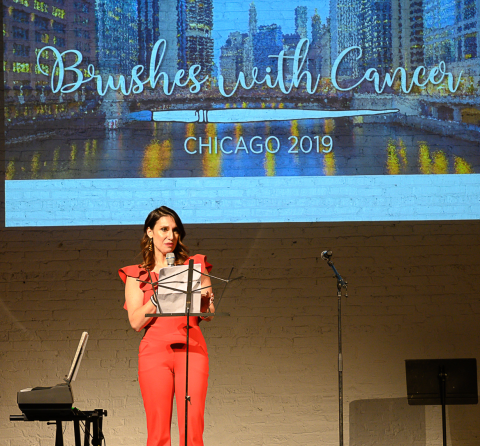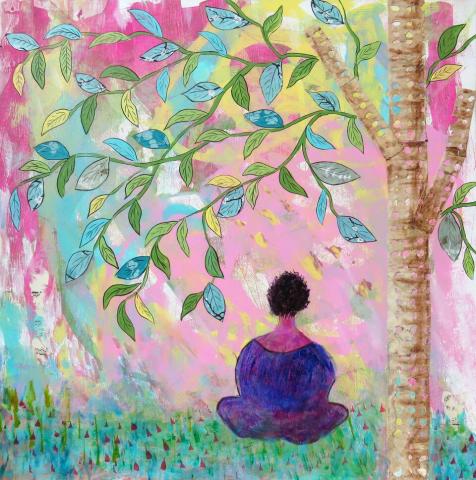
Twist Out Cancer is an international non-profit charitable organization that provides psychosocial support to individuals touched by cancer through creative arts programming, including a cool program that pairs a visual artist with a cancer patient or survivor.
Brushes With Cancer, Twist Out Cancer’s signature six-month program, matches those impacted by cancer with artists to create a unique piece of art that reflects on their personal journey. More than 1,000 people of all ages and genders have participated in the program, which has led to the creation of more than 500 pieces of art, such as: Michelle Kellner's New Roots, inspired by Jamie Rappoport's story about her brother's battle with stage 4 pancreatic cancer and her own journey as a "previvor" with the BRCA1 gene; and artists Karen Kingsolver and Beverly Dyer's work together on a piece based on a person who has since passed away.
The Brushes With Cancer program concludes with an art exhibit and celebratory event for the participants, their families and the community.
This year there are three Brushes With Cancer programs covering 28 northeastern, mid-western and southern American states. The northeast program will hold its celebratory event virtually at 4 p.m. EST on Oct. 10 (tickets are $75 USD).
Samaritan spoke with Twist Out Cancer executive board member and director of programs August Spree about Brushes With Cancer's origins, impact and how people are matched up.

Our founder Jenna Benn Shersher was diagnosed with grey zone lymphoma in her twenties and at the time had been passionate about dance. This was in the early days of YouTube and during her isolation she posted a video of herself doing “The Twist” and invited people to join her on the dancefloor because she was missing dancing and feeling pulled away from everyone. All of these people responded with their own “Twist” videos, joining in with her, and she realized there was this potential for a community even if you’re in a situation like that.
How did Brushes With Cancer start?
Brushes With Cancer has a similar story, where a friend of Jenna’s had put out a request to people to create a work of art that did not include grey because in her diagnosis and treatment she felt that she was only experiencing shades of grey. Then all of these people responded with their own art pieces. That was the birth of the Brushes With Cancer program itself and created an opportunity for these unexpected intersections of people who may not have met in regular life, but we matched them up one on one. It involves those who’ve been touched by cancer, who we call inspirations, and could be a survivor, a previvor or a caregiver, and then we match them with artists.
How did you become involved?
As a cancer survivor and someone who went through the program as well, I was 10 years beyond my diagnosis and my grandmother had passed away from cancer. When I started sharing with the first artist I was paired with, I was really surprised that there were things that I had never spoken out loud. Because when you’re going through it and your family and your loved ones are there with you, there are things that you don’t really talk about and how scared you are. Everyone’s trying to focus on the solution and move through it. The sharing and connecting provides an opportunity for an extra layer of healing for the inspirations.
How do the artists benefit?
The artists get the opportunity to create something from someone else’s perspective because art is often from the artist’s perspective. A lot of the feedback that we’ve heard is how great that is for them to have this opportunity to share someone else’s story through their art. A lot of time life-long relationships are born from that. I’m still with my artist that I was paired with seven years ago and we live together and have kids. I think we’re the only Brushes With Cancer love story, but there have been lots of long-term friendships that have been born from these experiences across borders and countries.
Yes. I stumbled into an event that was showcasing the art and, as a cancer survivor, it really struck a chord with me. Bringing art into the experience and using that as an expression was really meaningful to me as I read the stories and took in all of the art. So I walked up to Jenna and said “We’re going to be friends.” We had coffee a couple of weeks later and I asked how I could help. I started telling everyone about it and jumped into volunteering right away. It was Jenna who suggested that I participate the next time they launched a program so that I would be paired with an artist and know what the experience was like. From there I went to the advisory board and then the executive board and now director of programs. I’m a lifer.
How has the program grown in the years that you’ve been involved?
This is our 10th year and I’ve been involved for seven. That first year I walked in I believe there were 15 pairs and now we can’t accept all of the people that apply. For each program we try to limit it to 35 pairs, which is 70 participants, to give us the capacity to stay in touch with all of them.
What is the primary goal of Brushes With Cancer?
We use the statement “share, connect and heal,” and I would say everything is pretty well wrapped up in those three words.
What’s the application process for Brushes With Cancer?
The application process includes questions that encourage people to consider if they’re in a place where they’re open enough to connect with someone and hear their story. When people come into the program they’re already prepared to have empathy and be there for one another. It goes both ways. The inspirations are there to share their stories, but often a lot of our artists may have peripheral experiences with cancer as well. They share back and forth and sometimes there are even collaborative pieces if the inspirations are artistic in some way. We leave the relationship up to them and we have certain requirements, like that they meet a certain amount of times. Sometimes that’s over video chats and sometimes it’s in person. Over the last year-and-a-half or so it’s mostly been virtual, but some who are open and willing have met up in person.
How are inspirations and artists chosen?
We have a licensed therapist on staff who helped develop the questions and goes through the answers in a pre-screening to check for communication styles and a readiness to be present for the person that they’re matched with. Once she adds her notes we have a small committee that comes together to help match people. I go a lot on intuition. We try to pick people that have similarities, but sometimes it just comes down to thinking that these two people will get along.
What role do mentors play and how are they involved?
The mentors usually have a couple of matches that they’re managing. They’re mostly in the background. They kick off the connection and the first meeting is usually a three-way video call or phone call. They facilitate the introduction and let them know what to expect out of the relationship and the program. The mentor is there as their first point of contact for any sort of questions or troubleshooting.

We really leave that up to the pair. Sometimes they’re collaborative and the two will work together on a piece. Sometimes there are multiple pieces created. We’ve had everything from ball gowns to jewelry to music to canvas art. One memorable piece that an artist friend of mine created was an embellished bra for her breast cancer survivor match. We leave the medium and the method up to the artist.
What type of stories have you heard from people who’ve benefited by being involved?
There are definitely lots of stories about people healing. One particular story that sticks out to me involves one of our participants who passed away during the program. She was a beautiful soul. [Her] family wasn’t as dialed in to her support during her experience for whatever reason and her artist was someone who really set aside large chunks of time in her life to be present with her, from the hospital to back home to back in the hospital, to even speaking with her the day before she passed. For hours at a time they would be talking. [She] had shared with me during that time just how much her artist was helping her get through every day. She knew she could call her after a really difficult chemo treatment and hugging the toilet all morning and download and share with her, and she’d be there and listen. It was a beautiful connection and relationship that they had.
Do you use different artists every time or do you have a network of people that are involved more than others?
Both. Some artists repeat and really love participating in the program. We also have new artists that discover the program or are asked to participate for whatever reason. Some artists will participate and then skip a program and then participate because it’s an emotional and mental connection that’s required. It just depends.
What happens with the art that’s produced from Brushes With Cancer?
We do a celebratory event that reveals the art. We have a particularly vulnerable population so we’re staying virtual this year. But prior to that we would have 800-people galas that would be several hours, with all of the art on display. The point of that is to celebrate all of the participants. I like to say it celebrates the points of beauty that come from painful situations. Cancer is a difficult topic, but when you’re surrounded by all of these works of art it’s really amazing to look around and see how much beauty can come from this really ugly word.
We give the participants a first peek at the art for a week or two before it’s open to the public, and then it’s available for auction. All of those funds go right back into the Brushes With Cancer program because it’s free for all of the participants.
So the artists don’t receive any money or funding?
No. Everyone donates their time, energy and talent.
Do you know how much money has been raised from the auctions?
No. We don’t have that.
Watch a piece of art for Spree get created in real-time: